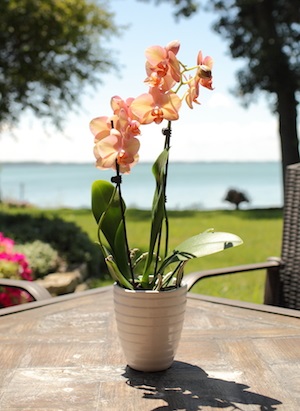
 As we move further into spring and closer to summer, we celebrate the warmth and renewal of the season. However, if you’re an orchid owner, be aware that warmer air can bring hidden threats to your beloved plant.
As we move further into spring and closer to summer, we celebrate the warmth and renewal of the season. However, if you’re an orchid owner, be aware that warmer air can bring hidden threats to your beloved plant.
Here, we discuss four springtime orchid threats lurking in the breeze and how you can protect your plant.
What’s one of the first things you do on the first warm spring day? Open a window! After a long, cold winter of being cooped up in the house, it’s nice to crack open a few windows to let some fresh air in. Air can be good for your orchid, too, just as long as that air isn’t too dry. Orchids crave moisture and humidity, and if the air around it is too hot, too dry or both, your plant will not thrive.
Tip: If you live in a desert or in an area with dry heat, do not put your orchid close to an open window.
A temperature between 65 and 80 degrees Fahrenheit during the day is ideal for orchid health; however, it’s often soon into the season when temperatures surpass the 80-degree mark. And when they do, you, like many people, switch on the air conditioning. This is great for cooling you and your family down, but it can be bad for your orchid. Cold snaps of air can shock your plant, which may cause premature bud fall, or “bud blast.”
Tip: Keep your orchid far away from the direct flow of air conditioners and vents. Place your flower in a room that is consistently between 65 and 80 degrees Fahrenheit during the day, and 55 and 65 degrees Fahrenheit during the night.
A fan can provide a quick, breezy cool down. This is why people often place fans in windows or run their ceiling funs on a high setting, especially at night. Orchids do well in temperatures of 55-65 degrees Fahrenheit at night, but in the direct line of a fan, the temperatures could drop well below this range.
Tip: If you use a fan to cool your home down, place you orchid away from the direct flow of air.
Orchids love humidity, but too much humidity is a bad thing. If you live in very humid climate, you will need to monitor your orchid’s humidity levels. Phalaenopsis orchids thrive when humidity levels are between 55 and 75 percent, but too much moisture encourages bacteria and fungal growth, which can lead to orchid diseases. A dead giveaway of too much moisture is a foul odor coming from your plant.
Tip: If you expose your plant to a high level of humidity during the day, “dry it out” at night by placing it in a low moisture area of your home. If your plant has a bacterial infection, treat it with a natural fungicide.
This spring and summer, enjoy the warm weather, but take these precautions into consideration to help shield your plant from harm.
Do you need more orchid care tips to keep your plant in tip-top shape? Visit our FAQs page to find the answers you’re searching for.

Copyright Just Add Ice® Orchids 2023